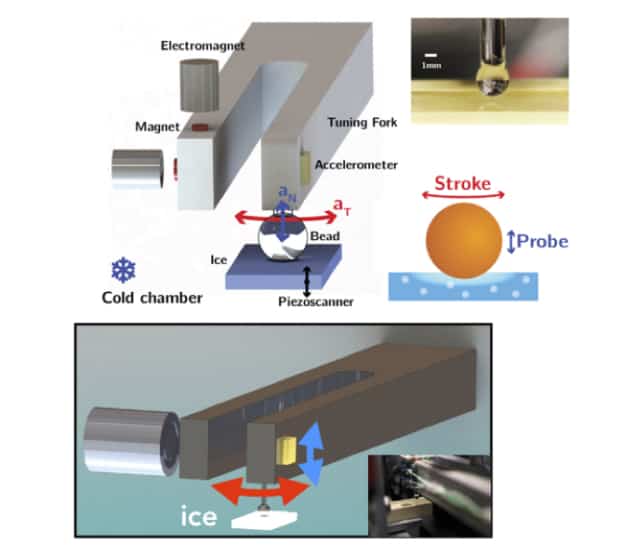
The liquid film that develops as an object glides across ice is as viscous as oil and much thinner than expected, say a team of researchers who have developed a way of probing the ice-water interface much more precisely than was previously possible.
Ice and snow have exceptionally low friction coefficients, making them good for skiing, skating and sledging, but dangerous for drivers on icy winter roads. Although these materials have been studied for more than 150 years, scientists still do not understand why they are so slippery.
Unanswered questions
Some have attributed the low friction coefficients to the formation of a thin layer of liquid water between the ice and the sliding object – caused, paradoxically, by frictional heating slightly melting the ice. However, this hypothesis raises many unanswered questions, says Lydéric Bocquet of the Physics Laboratory at the Ecole Normale Supérieure (ENS) in Paris. Water is a bad lubricant compared to oil, and the thickness and properties of the proposed interfacial water layer have not been measured. Indeed, its very existence has been under debate.
Now, however, a team led by Bocquet and his ENS colleague Alessandro Siria have used a new instrument – dubbed a stroke-probe tribometer – to measure the properties of this interfacial water layer. Their work shows that the liquid film does indeed exist, but it is just a few hundreds of nanometres to a micron in depth, and its viscoelastic properties resemble those of polymers or polyelectrolytes rather than simple water.
Tuning fork technique
Bocquet, Siria and colleagues studied “interfacial water” using a modified double-mode Tuning Fork Atomic Force Microscope (TF-AFM). The instrument they developed comprises a millimetre-sized probe ball glued to a macroscopic tuning fork. Although the fork is very similar to a piano tuning fork, it can be excited by a very low frequency vibration, typically several hundred Hertz. The system can be accurately modelled as a stiff mass-spring resonator with a quality factor of around 2500.

When the researchers bring the vibrating ball at the end of the fork in contact with the surface of a centimetre-sized block of ice (using a piezo element with an integrated motion sensor of nanometric resolution), the lateral stroke of the ball slides across the ice with a fixed amplitude and velocity. The frequency of the system then changes, but so does its quality factor.
The ENS team use the frequency offset to measure the elastic properties of the contact surface, and the change in quality factor to evaluate the dissipation processes occurring there. The two measurements together give the layer’s interfacial viscosity.
“Listening” to forces
The researchers say the instrument allows them to “listen” to the forces between the probe and the ice with remarkable precision. Indeed, despite being centimetres in size, the instrument’s sensitivity is such that it is possible to probe ice contact and friction properties at the nanometre scale. “The system allows us to access several vibration frequencies, offering us the possibility to simultaneously probe the tribology of the contact (‘how it rubs’) by moving the ball in a lateral direction and its rheology (‘how it flows’) by moving the ball in a perpendicular direction,” Bocquet explains.
The experiments confirm the super-slippery nature of the interfacial ice, but they also – for the first time – confirm that friction generates a film of liquid water when the probe ball is set in motion. This film is, however, much thinner than previous theoretical calculations have suggested, and it is also as viscous as oil, with a viscosity of up to hundreds of mPa-s – two orders of magnitude larger than the viscosity of water. The researchers also showed that the film’s viscosity depends on the shear velocity – a behaviour known as shear thinning.
Crushed ice and water state
According to Bocquet, one interpretation for this unexpected behaviour is that surface ice does not completely transform into liquid water when an object glides across it. Instead, it may enter a mixed “granité-like” (crushed ice and water) state. This mixed film, he suggests, lubricates the contact between the solid ice and the ball and prevents any direct contact between the two surfaces.
Separate experiments by the ENS team show that making the probe hydrophobic reduces friction even further by modifying the interfacial viscosity. This “waxing” process is practiced empirically by skiers, but the reason why it made skis glide better was not previously understood.

Physics of ski jackets, the eerie sound of thin ice, how figure skaters linger in mid-air
Towards a new theory for interfacial ice
The team’s result means that existing theoretical descriptions for interfacial ice need an overhaul, Bocquet tells Physics World. A new theory would provide a better understanding of sliding on ice, which would come in useful in developing winter sports equipment or self-healing, ultra-low-friction lubricants for industrial applications. It might also help, conversely, to find ways of increasing friction, which is essential to avoid slipping on icy roads.
Angelos Michaelides of University College London, UK, who was not involved in the research, says that the ENS study is very exciting. “I am not aware of such a nice and elegant set of measurements on the friction of the quasi-liquid layer and think it is an extremely interesting new perspective on this age-old story,” he comments.
The research is described in Physical Review X.



